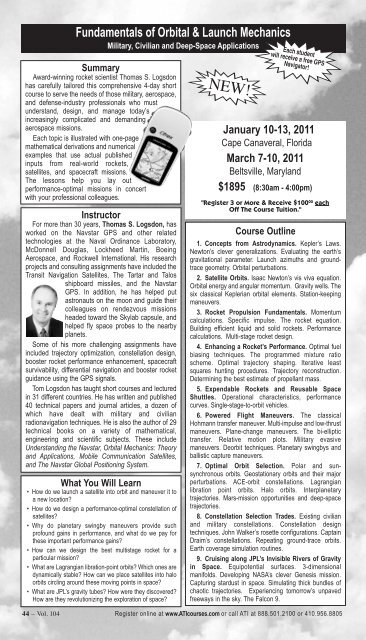Systems Engineering - ATI
Systems Engineering - ATI
Systems Engineering - ATI
You also want an ePaper? Increase the reach of your titles
YUMPU automatically turns print PDFs into web optimized ePapers that Google loves.
Fundamentals of Orbital & Launch Mechanics<br />
Summary<br />
Award-winning rocket scientist Thomas S. Logsdon<br />
has carefully tailored this comprehensive 4-day short<br />
course to serve the needs of those military, aerospace,<br />
and defense-industry professionals who must<br />
understand, design, and manage today’s<br />
increasingly complicated and demanding<br />
aerospace missions.<br />
Each topic is illustrated with one-page<br />
mathematical derivations and numerical<br />
examples that use actual published<br />
inputs from real-world rockets,<br />
satellites, and spacecraft missions.<br />
The lessons help you lay out<br />
performance-optimal missions in concert<br />
with your professional colleagues.<br />
Instructor<br />
For more than 30 years, Thomas S. Logsdon, has<br />
worked on the Navstar GPS and other related<br />
technologies at the Naval Ordinance Laboratory,<br />
McDonnell Douglas, Lockheed Martin, Boeing<br />
Aerospace, and Rockwell International. His research<br />
projects and consulting assignments have included the<br />
Transit Navigation Satellites, The Tartar and Talos<br />
shipboard missiles, and the Navstar<br />
GPS. In addition, he has helped put<br />
astronauts on the moon and guide their<br />
colleagues on rendezvous missions<br />
headed toward the Skylab capsule, and<br />
helped fly space probes to the nearby<br />
planets.<br />
Some of his more challenging assignments have<br />
included trajectory optimization, constellation design,<br />
booster rocket performance enhancement, spacecraft<br />
survivability, differential navigation and booster rocket<br />
guidance using the GPS signals.<br />
Tom Logsdon has taught short courses and lectured<br />
in 31 different countries. He has written and published<br />
40 technical papers and journal articles, a dozen of<br />
which have dealt with military and civilian<br />
radionavigation techniques. He is also the author of 29<br />
technical books on a variety of mathematical,<br />
engineering and scientific subjects. These include<br />
Understanding the Navstar, Orbital Mechanics: Theory<br />
and Applications, Mobile Communication Satellites,<br />
and The Navstar Global Positioning System.<br />
What You Will Learn<br />
• How do we launch a satellite into orbit and maneuver it to<br />
a new location<br />
• How do we design a performance-optimal constellation of<br />
satellites<br />
• Why do planetary swingby maneuvers provide such<br />
profound gains in performance, and what do we pay for<br />
these important performance gains<br />
• How can we design the best multistage rocket for a<br />
particular mission<br />
• What are Lagrangian libration-point orbits Which ones are<br />
dynamically stable How can we place satellites into halo<br />
orbits circling around these moving points in space<br />
• What are JPL’s gravity tubes How were they discovered<br />
How are they revolutionizing the exploration of space<br />
Military, Civilian and Deep-Space Applications<br />
NEW!<br />
January 10-13, 2011<br />
Cape Canaveral, Florida<br />
March 7-10, 2011<br />
Beltsville, Maryland<br />
$1895 (8:30am - 4:00pm)<br />
"Register 3 or More & Receive $100 00 each<br />
Off The Course Tuition."<br />
Course Outline<br />
Each student<br />
will receive a free GPS<br />
Navigator!<br />
1. Concepts from Astrodynamics. Kepler’s Laws.<br />
Newton’s clever generalizations. Evaluating the earth’s<br />
gravitational parameter. Launch azimuths and groundtrace<br />
geometry. Orbital perturbations.<br />
2. Satellite Orbits. Isaac Newton’s vis viva equation.<br />
Orbital energy and angular momentum. Gravity wells. The<br />
six classical Keplerian orbital elements. Station-keeping<br />
maneuvers.<br />
3. Rocket Propulsion Fundamentals. Momentum<br />
calculations. Specific impulse. The rocket equation.<br />
Building efficient liquid and solid rockets. Performance<br />
calculations. Multi-stage rocket design.<br />
4. Enhancing a Rocket’s Performance. Optimal fuel<br />
biasing techniques. The programmed mixture ratio<br />
scheme. Optimal trajectory shaping. Iterative least<br />
squares hunting procedures. Trajectory reconstruction.<br />
Determining the best estimate of propellant mass.<br />
5. Expendable Rockets and Reusable Space<br />
Shuttles. Operational characteristics, performance<br />
curves. Single-stage-to-orbit vehicles.<br />
6. Powered Flight Maneuvers. The classical<br />
Hohmann transfer maneuver. Multi-impulse and low-thrust<br />
maneuvers. Plane-change maneuvers. The bi-elliptic<br />
transfer. Relative motion plots. Military evasive<br />
maneuvers. Deorbit techniques. Planetary swingbys and<br />
ballistic capture maneuvers.<br />
7. Optimal Orbit Selection. Polar and sunsynchronous<br />
orbits. Geostationary orbits and their major<br />
perturbations. ACE-orbit constellations. Lagrangian<br />
libration point orbits. Halo orbits. Interplanetary<br />
trajectories. Mars-mission opportunities and deep-space<br />
trajectories.<br />
8. Constellation Selection Trades. Existing civilian<br />
and military constellations. Constellation design<br />
techniques. John Walker’s rosette configurations. Captain<br />
Draim’s constellations. Repeating ground-trace orbits.<br />
Earth coverage simulation routines.<br />
9. Cruising along JPL’s Invisible Rivers of Gravity<br />
in Space. Equipotential surfaces. 3-dimensional<br />
manifolds. Developing NASA’s clever Genesis mission.<br />
Capturing stardust in space. Simulating thick bundles of<br />
chaotic trajectories. Experiencing tomorrow’s unpaved<br />
freeways in the sky. The Falcon 9.<br />
44 – Vol. 104 Register online at www.<strong>ATI</strong>courses.com or call <strong>ATI</strong> at 888.501.2100 or 410.956.8805

















